Pillows—they’re essential to a good night’s sleep, but over time, many pillows begin to take on a yellowish hue. Recently, a lively debate about “The Yellow Pillow” has swept across social media, sparking curiosity and even nostalgia among users. This unexpected discussion sheds light on why pillows turn yellow and the reasons so many people find comfort in them despite their appearance. So, what exactly is behind this common phenomenon?
The Viral Debate Over The Yellow Pillow
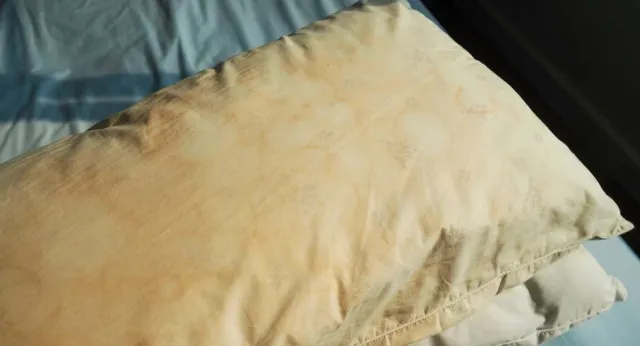
The conversation started when a man named Cam took to social media to share a photo of his beloved, albeit very yellow, pillow. He posted on X (formerly known as Twitter), humorously noting, “My girlfriend is mad at me because I revealed to her The Yellow Pillow. Fellas, I’m sure you all know that this thing is magic. It’s not my fault the pillow is yellow and bestows upon me the most peaceful slumber.”
Cam’s post quickly gained traction, with thousands of users weighing in. Many men echoed his sentiments, confessing their own attachment to yellowed pillows. Others, however, were less enthusiastic, describing the condition as unsanitary and prompting questions about the pillow’s origins. One user joked, “I haven’t rested comfortably since I got rid of my yellow pillow!” Another shared that their “life has been a downward spiral” since parting with theirs. This post highlighted a curious attachment to the yellow pillow, prompting questions about its cause and cultural significance.
Why Do Pillows Turn Yellow? The Science Behind It
The debate led many to ask: why do pillows turn yellow in the first place? The answer lies in a mix of natural bodily functions and personal habits. Let’s explore the main reasons behind this discoloration.
1. Sweat: The Main Culprit
The most common cause of pillow yellowing is sweat. Even if you don’t realize it, your body produces sweat throughout the night. Over time, this sweat seeps into the pillowcase and eventually into the pillow itself. The sweat contains urea and salts, which can stain the pillow fabric, resulting in a yellowish tint. This yellowing is simply a buildup from nights of restful sleep, but it can be prevented with regular pillow maintenance.
2. Saliva and Drool: Adding to the Discoloration
For those who tend to drool in their sleep, saliva can contribute to the yellowing process. Saliva, like sweat, contains natural enzymes and minerals that, over time, can lead to stains on fabric. When this moisture seeps into the pillow, it accelerates the discoloration. If you’re someone who sleeps with your mouth open or tends to drool, you’re more likely to notice yellowing on your pillows.
3. Natural Oils From Skin and Hair
Our skin and hair produce natural oils that, while necessary for health, can cause staining. Throughout the night, these oils transfer onto the pillowcase and then onto the pillow itself. The accumulation of these oils over time can lead to discoloration. Additionally, people with oily skin or those who use hair products may see yellowing more quickly, as these oils penetrate the pillow fabric and contribute to the yellow hue.
4. Skincare Products and Nighttime Routines
If you follow a nighttime skincare routine, the products you use can also play a role in pillow yellowing. Moisturizers, serums, and other skincare products often contain oils and active ingredients that can rub off onto the pillow while you sleep. These products can leave a residue on the pillow, and over time, the residue builds up, creating yellow stains. While these products are great for your skin, they can have a lasting impact on your pillow’s appearance.
5. Damp Hair: Another Source of Moisture
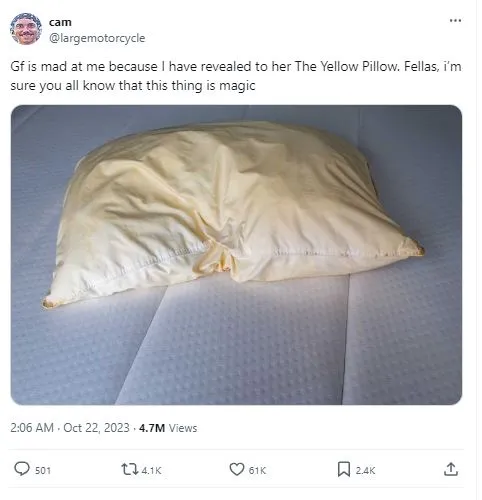
Going to bed with wet or damp hair may seem harmless, but it can also contribute to pillow yellowing. Hair holds water and, in some cases, leftover shampoo or conditioner residue, which can seep into the pillow as you sleep. This moisture creates the perfect environment for yellow stains to form. To keep your pillow fresh, it’s a good idea to ensure your hair is dry before hitting the hay.
Why Do People Love Their Yellow Pillows So Much?
While many find the appearance of a yellow pillow off-putting, there’s a surprising number of people who are deeply attached to their yellowed pillows. This attachment goes beyond comfort and delves into sentimentality. Over time, pillows mold to our unique sleeping habits, providing a personalized sleep experience. For many, the softness and familiarity of an old pillow offer unmatched comfort, making it difficult to replace.
The debate revealed that some people view their yellow pillows as trusted sleep companions. One person joked that their yellow pillow had “seen them through some of the best naps of their life,” while another claimed that their sleep quality had never been the same since discarding theirs. For these individuals, the yellowing is simply a part of the pillow’s story—a testament to countless nights of peaceful slumber.
How to Prevent Pillow Yellowing
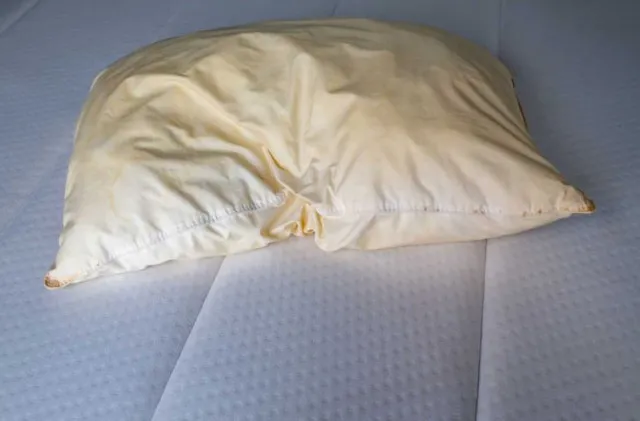
While yellow pillows may be comforting for some, not everyone is a fan of the look or the hygiene concerns it raises. If you prefer to keep your pillows looking fresh and clean, here are a few tips to prevent yellowing:
1. Use Pillow Protectors
Pillow protectors are a simple but effective way to keep sweat, saliva, and oils from seeping into your pillow. They add an extra layer of defense between your pillow and the elements that cause discoloration. Remember to wash these protectors regularly to maintain a clean pillow surface.
2. Wash Your Pillowcases Frequently
Changing and washing your pillowcases at least once a week can significantly reduce yellowing. Pillowcases collect oils, sweat, and skincare residue, so washing them frequently helps prevent buildup. Opt for gentle, fragrance-free detergents to keep your pillowcase fresh without any harsh chemicals.
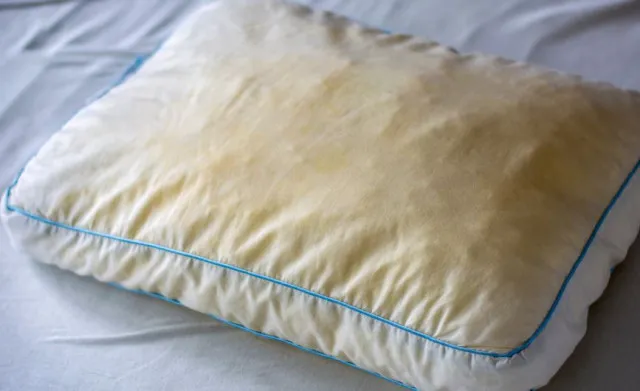
3. Wash Your Pillows Every Few Months
Most pillows are machine washable, making it easy to remove accumulated oils and moisture. Check the care label on your pillow for washing instructions, and aim to wash it every three to six months. Regular washing will keep your pillow fresh and help prolong its lifespan.
4. Avoid Sleeping with Damp Hair
As mentioned earlier, damp hair contributes to pillow yellowing. If you’re in the habit of showering before bed, try drying your hair completely before lying down. This will reduce the amount of moisture your pillow absorbs and help keep it looking clean.
5. Maintain a Cool Sleep Environment
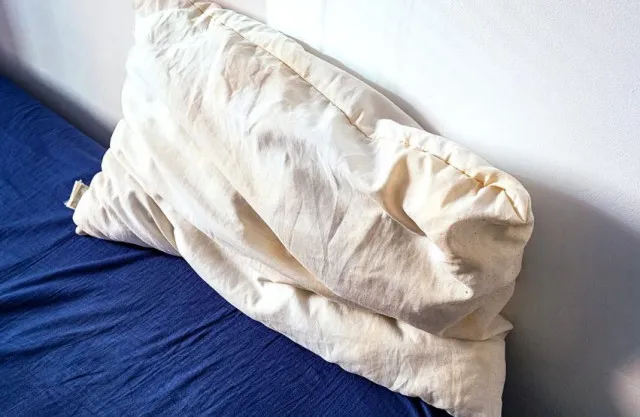
Sweating less during sleep can also reduce yellowing. Consider setting your room temperature to a comfortable, cool level to minimize night sweats. You can also invest in breathable pillowcases and pillows designed to regulate temperature.
Conclusion: Embracing or Avoiding the Yellow Pillow
The viral discussion surrounding “The Yellow Pillow” has brought attention to an often-overlooked part of our sleep routine. While some people see yellowed pillows as comforting relics, others are keen to avoid the discoloration altogether. By understanding the causes behind pillow yellowing, you can make informed choices about how to care for your pillows and keep them looking—and feeling—fresh.
Whether you embrace the yellow pillow or work to keep yours pristine, one thing is clear: our pillows are much more than just a sleep accessory. They’re our partners in rest, providing comfort night after night, stains and all.


